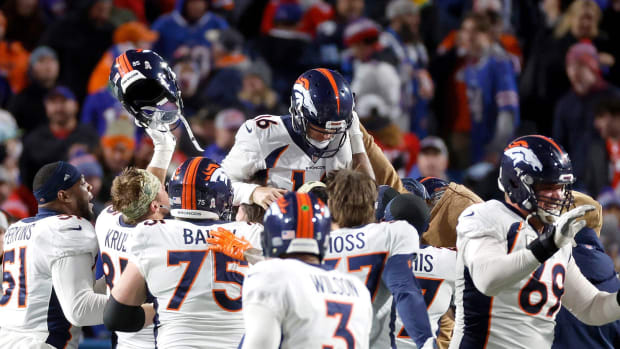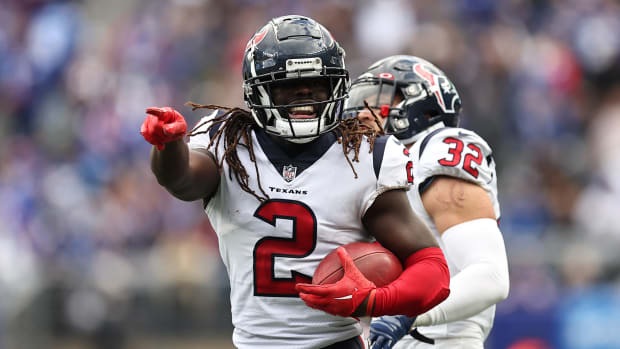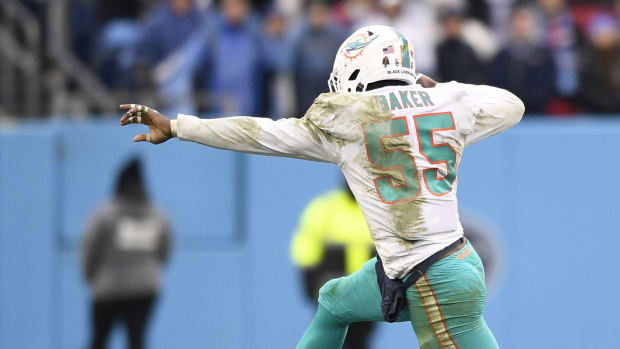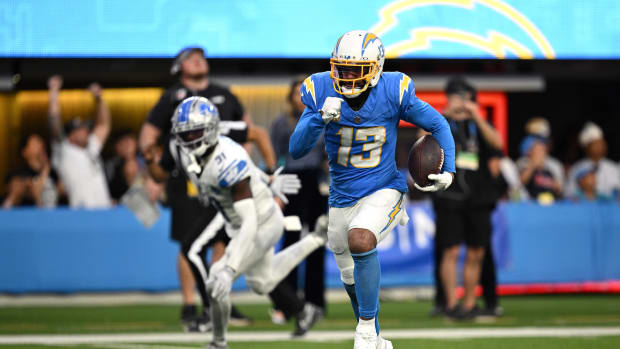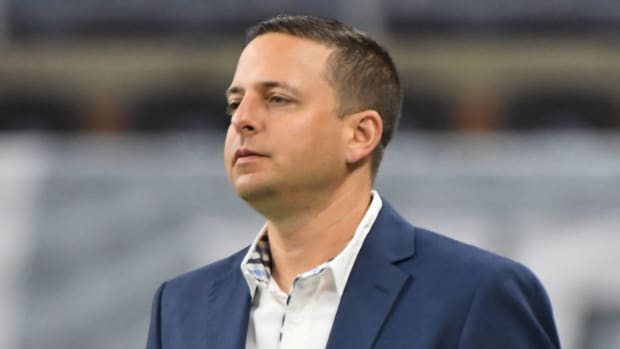
Helmets alone won't save football from concussions
Many of us don't want football to change. We want the game to remain the hard-hitting spectacle that has caused it to grow into America's most popular sport. However, in the face of the concussion crisis, change is needed to make the game safer. We look for answers that allow the game to stay the same, but alleviate brain injuries, so we can watch, and the players can play, with a clear conscience. To preserve the game and protect the players, the NFL, helmet manufacturers, fans and many in the media think that to save the brain, we must improve the helmet.
That leads engineers to ponder new shapes, hi-tech materials and novel padding configurations. The latest entry in the canon of stories on headgear science appears in the January issue of Popular Science, on "The Helmet That Can Save Football." This helmet will not do that. To understand why, you first have to know what leading researchers believe causes concussions. Once you do, you'll realize helmets alone won't save us from the crisis.
Down at the University of Tennessee, Dave Halstead leads the Sports Biomechanics Impact Research Laboratory, and is the technical director of the Southern Impact Research Center. His labs test equipment and study how injuries occur in order to make protective gear more effective. For the last few decades his focus has been injuries to the head and neck, where his work has gone beyond just testing. In 1986 he led the design of a football helmet that became the standard model adopted by the NFL, and in 2000 designed yet another helmet that's still in use in the league alongside his earlier design. If anyone could speak to a helmet's abilities, it's him.
Halstead says helmets are accomplishing what they're designed to do: prevent skull fractures. "The helmet makes the head as resilient to injury as the rest of the body is," Halstead says. "The rest of the body can take a 25-26 mph impact, the head can't. The head is about 8 mph for a death sentence. You think, 'how can that be?'"
Well, from the time we humans are able to walk and then run, we find ways to protect our head so that it's not the first thing to get hit in the event of a collision. We protect our cranium in a way that makes other parts of the body absorb an impact before the head does. But the equation changes when we decide to do something like ride a bike or play football. "Your reflexes are lagging behind what's going to occur and you end up hitting your head first, and there's a risk of death," Halstead says. So we put on a helmet -- one that meets a minimum industry impact resistance standard, as all NFL and NHL helmets do -- and our skulls don't split open and we don't die from a linear impact straight to the head.
"Now people wearing the helmets ask, 'I'm getting a concussion, what's up with that?' " Halstead says. That's because there are two ways to get concussed from a hit. The first is linear impact, measured in g-forces, where a concussion happens when you're subjected to around 100gs. The other way is from rotational acceleration of the head at your cervical spine, which is a fancy way of saying your head whipping around on your neck. This damages the brain by exerting shear stress on its axons. Scientists measure the motion in radians, and the threshold for concussion is around 6,000 radians/sec2.
Now, this is where things get a little perverse. Protecting our heads from the linear impact has made the rotational accelerations a problem we have to worry about. "If I don't have a helmet on and my head hits the ground, I have an oozing skull fracture and no one cares how many radians my head rotates at because I have a life-threatening or life-ending event," Halstead says. "But if I have a helmet on, the helmet manages that energy, I only get 30gs from the impact. But then I have 6,000 radians/sec2 of sheer force. The helmet is just along for a ride, because the real problem is the motion prior to and after impact."
Despite the helmet just being along for the ride, much of the discussion about improving player safety has focused on headgear. We've come to see head injuries as a problem we can use technology to solve. Recently, SI's Will Carroll wrote about the new helmet being designed by IndyCar racing's Bill Simpson and Chip Ganassi. Their model boasts carbon fiber and Kevlar and an innovative interior padding that exceeds the industry standard for helmets when it comes to cushioning impact. However, when Pop Sci asked Simpson if the helmet could reduce concussions, he responded, "Oh, hell no. I would never make a claim about that."
Taking a different tack, a Swedish company created MIPS (Multi-Directional Impact Protection System), the helmet Popular Science reports will save football. Its outer shell can shift slightly on top of its inner liner at impact. The idea is that allowing for this shift will reduce rotational accelerations by absorbing some of the impact's force. Think of how crumple zones dissipate energy in a car accident by flexing. This layer doesn't crumple, but the same idea is to allow for some movement to dissipate energy -- in the MIPS case, the helmet's outer shell rotating -- so not all of the force of the hit is transferred to the head, MIPS creators argue. In a similar vein to MIPS, Michael Princip, a designer for an Aerospace firm, created headgear that had four separate sections that comprised the outer shell. Those partitions, fastened atop a padding layer, move independently of each other when hit, absorbing more of the impact.
If successful, all of these models will dissipate plenty of the g-forces of a linear impact straight to the head, but will do nothing to alleviate the rotational acceleration of the head. With the MIPS helmet, there is a claim of a reduction in rotational acceleration, however, that assumes the axis of rotation is the center of the head, spinning like in a scene from The Exorcist. But, as I wrote above, it's not. The rotational acceleration that causes concussions happens from the neck. They're solving a problem that's not actually the problem. For instance, the MIPS helmet would be useless preventing a concussion from a shoulder-to-shoulder hit that causes the head to whip back and forth. "You don't have to hit your head to get these injuries," Halstead says, "Let me repeat that. You don't have to hit your head to get these injuries. So how is a helmet going to prevent them since I don't have to hit my head to get them?"
Which leaves us with an uncomfortable question -- can we not rely on helmets? The chief medical officer for USA Hockey doesn't know if we can. "There is no scientific evidence to prove that the hockey helmet reduces the risk of concussion," the Mayo Clinic's Dr. Michael Stuart, Vice-Chair of Orthopedic Surgery and the co-director of its Sports Medicine Center told SI's Stu Hackel earlier this year. "Now maybe it does, but we don't have sound scientific evidence."
Last year, ESPN.com columnist Gregg Easterbrook argued for better research and testing for helmets, citing a February 2006 study in the journal Neurosurgery (a non-peer-reviewed journal, meaning a study's results are not independently and rigorously checked before publish), that advanced helmets lowered concussions by around one-third. However, this study touting the effectiveness of Riddell's advanced helmets had a Riddell employee as one of the researchers. Also, in a comment that accompanied the study, the co-founder of the Sports Legacy Institute Dr. Robert Cantu cited further faults with the research. Cantu, who has been a leader studying football players' brains after death, wrote that the methodology was flawed enough to not conclusively support the study's findings that the advanced helmets lowered concussions.
We may need to accept the limitations of the helmet and not give the impression that a perfect model exists out there that will prevent concussions. "That mindset exists that 'we're doing the best we can, even if it's not proven,'" Halstead says. "The favorite thing I hear is 'even a little bit is better than nothing, right?' And I go, how about a dozen condoms each with a tiny pinhole in them, they're better than nothing right? Clearly it's better than nothing, but it's completely ineffective for what it's designed to do and as a consequence, when you don the condom or device and you think it's going to do something for you that it doesn't, you've had a disservice done to you."

































